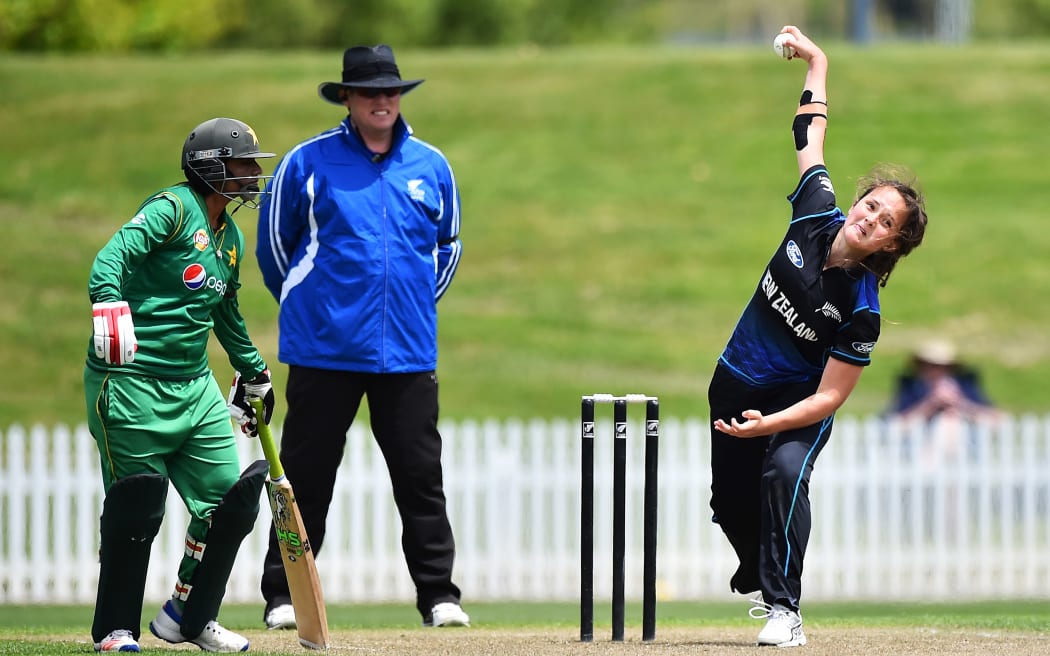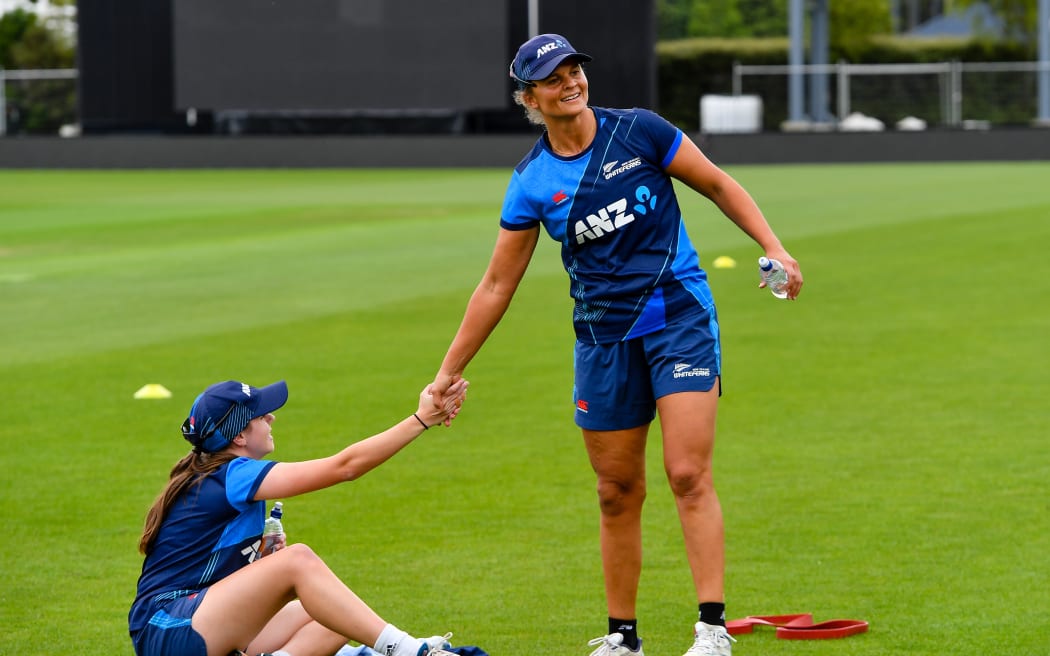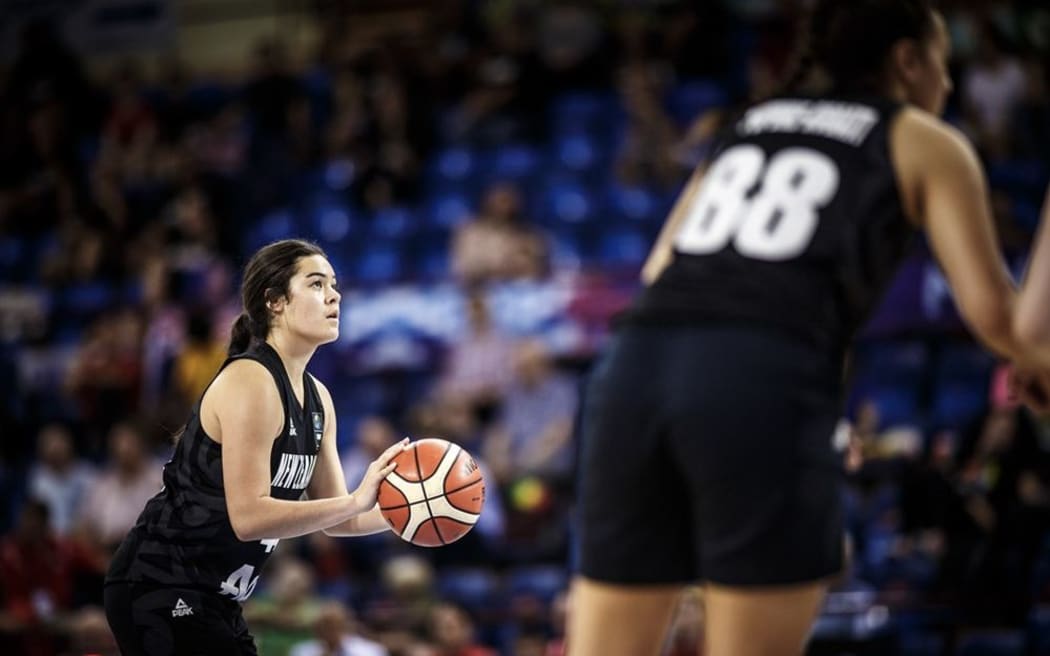
White Ferns player Amelia Kerr during her first senior ODI series against Pakistan 2016. Kerr was 16-years-old. Photo: Photosport
Prodigious teenage talents can burst onto the international sporting stage but national sporting organisations are increasingly cautious about letting them loose too soon.
In New Zealand it tends to be women's teams that have teenagers making international debuts but men's teams can also have more than a decade between the oldest and youngest in a side.
Generation gap
At last year's Women's T20 World Cup there was 17 years between the oldest White Fern (35-year-old Suzie Bates) and the youngest (18-year-old Fran Jonas).
Football Fern Milly Clegg was the youngest member of New Zealand's FIFA World Cup squad last year at 17 years old and the most inexperienced with two caps. By comparison co-captain Ali Riley was the oldest at 35 with 152 caps to her name before the tournament kicked off in Auckland.
At her second Netball World Cup last year Silver Ferns defender and mum Jane Watson was the oldest in the New Zealand side at 33. She was 12 years older than goal shooter Grace Nweke.

The youngest current White Fern Fran Jonas and the oldest Suzie Bates give each other a helping hand. Photo: John Davidson/www.photosport.nz
The All Blacks 33-strong Rugby World Cup squad for France had nine players in their 30s. Hooker Dane Coles was the oldest at 36 and halfback Cam Roigard was the youngest at 22.
Ahead of the 2023 FIBA World Cup Basketball New Zealand described the Tall Blacks roster as "a blended squad of veteran talent and young athletes".
With an average age of 26 years and 7 months, a decade separated the youngest Tall Black 20-year-old Walter Brown and Shea Ili and Jordan Ngatai who were both 30.
Of the 16 players involved in the Black Caps ODI World Cup campaign last year 12 were in their 30s. Allrounder and one of the stars of the tournament Rachin Ravindra was the youngest at 23.
Remembering they are minors
The Tall Ferns added 16-year-old Pahlyss Hokianga to their squad for this month's Olympic Qualifiers in China as an injury replacement for Charlisse Leger-Walker.
Hokianga took the court against world number 2 China on 9 February at 16 years 115 days old, to become New Zealand's youngest ever Tall Fern - passing Leger-Walker who made her debut at the 2018 Commonwealth Games aged 16 years and 202 days.

New Zealand basketballer Pahlyss Hokianga Photo: Supplied
When Hokianga's late call-up was announced Basketball New Zealand women's high performance programme manager and former Tall Fern Lisa Wallbutton said the team had placed an increased focus on having the right support systems in place for its players - particularly with young athletes such as Hokianga and 18-year-olds Lauren Whittaker and Ritorya Tamilo involved.
"It's important to us and the players that we can provide a safe, supportive space for our younger athletes so they can feel comfortable in the Tall Ferns environment - both on and off the court," Wallbutton said.
Hokianga had ticked off a number of pre-tour medical checks and Basketball New Zealand was confident she could deal with the physical demands of the training camp and the tournament.
A travelling sport psychologist helped with the mental challenges of the pressure environment.
Wallbutton acknowledged there were challenges to integrating young players but teenagers had been making their senior debut for the Tall Ferns for years.
"It's remembering that they are minors, that they are children and they're coming into that high performance environment with adults so just really helping them to bridge the gap with pastoral care and having the performance team wrapped around them and having a good culture within the team that we welcome and foster and look after the young athletes as they come through.
"Generally within the playing group I can't think of anyone off the top of my head that doesn't relish and step into that role of mentoring and encouraging the younger athletes. I think we've got a really nice balance within the playing group at the moment."

Charlisse Leger-Walker of New Zealand in action against China on 29 July 2018. Photo: Photosport
Stepping up to the senior side can be a reality check for some.
"When they've been the best talent in their age group they're playing a lot of minutes, they're scoring a lot of points, getting a lot of rebounds, leading the stat sheet and then they come into this environment and they might only play a couple of minutes here and there ... your impact might be slightly different so it's negotiating that and learning how you can bring value in the role you are filling within this team.
"I think the coaches are doing a really nice job of role definition and trying to make the athletes confident in what they want them to bring to the team."
Wallbutton wanted all players to have a good Tall Ferns' experience so that they wanted to come back.
No White Ferns under 16
In 1997 New Zealand Cricket selected an 18-year-old Daniel Vettori to make his Test debut, making the spinner the youngest male to wear the black cap. The same year Vettori joined the squad Dipak Patel played his last Test for New Zealand as a 38-year-old.
Amelia Kerr became the youngest White Fern when she debuted as a 16-year-old in 2016, playing alongside her that day was Liz Green (nee Perry) who was 28 years old at the time.
Green is now New Zealand Cricket's head of women's high performance and Kerr is into her ninth year in the national team.

Liz Perry and Amelia Kerr at a school visit a year after a teenage Kerr made her debut. Photo: Photosport
Green and Kerr also played domestic cricket together for Wellington and were room mates early in Kerr's career.
"Melie was roomed with me for one of the warm up matches purely from that sense of Melie being in and around a senior leader in the team at the time, I think I might have been captain, it was pretty daunting I'm pretty sure for Melie to come into a senior women's environment as a 16-year-old [who was] hugely talented [with] lots of potential.
"I just remember putting my arm around her and trying to make her feel as comfortable and happy and safe in the environment as possible," Green said.
"It only took her a year before she started to give me a bit of grief and a bit of banter so it must have worked."
Green described Kerr as rare talent who comes along only once a decade.
Jonas and a few other younger players coming into the White Ferns in recent seasons has been a "catalyst" for New Zealand Cricket to look at their processes, Green said.
Psychologists and mental skills coaches as well as the Cricket Players Association provide resources to help players adjust.

Suzie Bates is one of the older players in the White Ferns. Photo: Michael Thomas / www.photosport.nz
"I'd say some of the senior players are probably feeling outnumbered with some of the young players coming through," said Green.
"We've got a lot of younger White Ferns at the moment who have probably formed their own little group in the team and they've found their feet quite quickly. It almost makes some of the older players like Suzie Bates and Sophie Devine probably feel a bit old in the environment but I haven't experienced there to be any separation or differentiation between the groups.
"Also I think someone like Melie Kerr who is highly experienced and has been in and around the team for a long time but is still very young in age she takes on a bit of a leadership role within the group with some of those younger players."
Previously new players were selected for the White Ferns simply based on talent, not whether they were ready for the international stage.
However, New Zealand Cricket have drawn a line at how young is too young.
Maturity comes into it and the "brutal" international cricket environment.
"Anyone under the age of 16 we don't look at from a White Ferns perspective or talent perspective. We want to make sure our processes are in place so that when they do enter a high performing environment that they are ready to go.
"The assessment of the environment and then the assessment of the player themselves in terms of risk mitigation is something we take great pride in and we're not saying we get it right but we are mindful that with the ever changing landscape of cricket and our view on wanting to be successful on the international stage that nurturing of talent is really vital."
Green expects a changing of the guard after the 2025 50 over World Cup in India and more younger players to be coming through.


